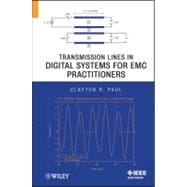
What is included with this book?
| Preface | p. xi |
| ansmission Lines: Physical Dimensions vs Electric Dimensions | p. 1 |
| Waves, Time Delay, Phase Shift, Wavelength, and Electrical Dimensions | p. 4 |
| Spectral (Frequency) Content of Digital Waveforms and Their Bandwidths | p. 10 |
| The Basic Transmission-Line Problem | p. 22 |
| Time-Domain Analysis of Two-Conductor Lines | p. 31 |
| The Transverse Electromagnetic Mode of Propagation and the Transmission-Line Equations | p. 32 |
| The Per-Unit-Length Parameters | p. 37 |
| Wire-Type Lines | p. 37 |
| Lines of Rectangular Cross Section | p. 47 |
| The General Solutions for the Line Voltage and Current | p. 50 |
| Wave Tracing and Reflection Coefficients | p. 54 |
| A Simple Alternative to Wave Tracing in the Solution of Transmission Lines | p. 60 |
| The Spice (PSPICE) Exact Transmission-Line Model | p. 70 |
| Lumped-Circuit Approximate Models of the Line | p. 75 |
| Effects of Reactive Terminations on Terminal Waveforms | p. 84 |
| Effect of Capacitive Terminations | p. 85 |
| Effect of Inductive Terminations | p. 87 |
| Matching Schemes for Signal Integrity | p. 89 |
| Effect of Line Discontinuities | p. 96 |
| Driving Multiple Lines | p. 101 |
| Frequency-Domain Analysis of Two-Conductor Lines | p. 103 |
| The Transmission-Line Equations for Sinusoidal Steady-State (Phasor) Excitation of the Line | p. 104 |
| The General Solution for the Line Voltages and Currents | p. 105 |
| The Voltage Reflection Coefficient and Input Impedance of the Line | p. 106 |
| The Solution for the Terminal Voltages and Currents | p. 108 |
| The SPICE Solution | p. 111 |
| Voltage and Current as a Function of Position on the Line | p. 112 |
| Matching and VSWR | p. 115 |
| Power Flow on the Line | p. 117 |
| Alternative Forms of the Results | p. 120 |
| Construction of Microwave Circuit Components Using Transmission Lines | p. 120 |
| Crosstalk in Three-Conductor Lines | p. 125 |
| The Multiconductor Transmission-Line Equations | p. 125 |
| The MTL Per-Unit-Length Parameters of Inductance and Capacitance | p. 131 |
| Wide-Separation Approximations for Wires | p. 135 |
| Numerical Methods | p. 145 |
| The Approximate Inductive-Capacitive Crosstalk Model | p. 155 |
| The Inductive-Capacitive Coupling Approximate Model | p. 159 |
| Separation of the Crosstalk into Inductive and Capacitive Coupling Components, 166 | |
| Common-Impedance Coupling | p. 172 |
| Effect of Shielded Wires in Reducing Crosstalk | p. 173 |
| Experimental Results | p. 182 |
| Effect of Shield Pigtails | p. 183 |
| Experimental Results | p. 187 |
| Effect of Multiple Shields | p. 188 |
| Experimental Results | p. 188 |
| Effect of Twisted Pairs of Wires in Reducing Crosstalk | p. 197 |
| Experimental Results | p. 203 |
| The Shielded Twisted-Pair Wire: The Best of Both Worlds | p. 209 |
| The Exact Crosstalk Prediction Model | p. 211 |
| Decoupling the Transmission-Line Equations with Mode Transformations | p. 212 |
| The SPICE Subcircuit Model | p. 215 |
| Lumped-Circuit Approximate Models of the Line | p. 231 |
| A Practical Crosstalk Problem | p. 237 |
| Brief Tutorial on Using PSPICE | p. 245 |
| Index | p. 267 |
| Table of Contents provided by Ingram. All Rights Reserved. |
The New copy of this book will include any supplemental materials advertised. Please check the title of the book to determine if it should include any access cards, study guides, lab manuals, CDs, etc.
The Used, Rental and eBook copies of this book are not guaranteed to include any supplemental materials. Typically, only the book itself is included. This is true even if the title states it includes any access cards, study guides, lab manuals, CDs, etc.